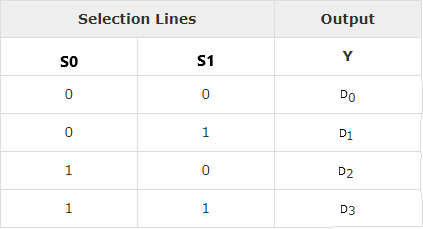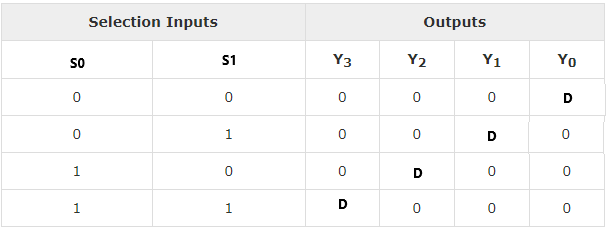Experiments-5
Implementation of 4x1 multiplexer and 1x4 demultiplexer using logic gates.
Introduction
The function of a multiplexer is to select the input of any ‘n’ input lines and feed that to one output line. The function of a de-multiplexer is to inverse the function of the multiplexer and the shortcut forms of the multiplexer. The de-multiplexers are mux and demux. Some multiplexers perform both multiplexing and de-multiplexing operations.

Figure-1:Block diagram of Multiplexer and De-multiplexer
1) Multiplexer Multiplexer is a device that has multiple inputs and a single line output. The select lines determine which input is connected to the output, and also to increase the amount of data that can be sent over a network within certain time. It is also called a data selector.
Multiplexers are classified into four types:
a) 2-1 multiplexer (1 select line)
b) 4-1 multiplexer (2 select lines)
c) 8-1 multiplexer(3 select lines)
d) 16-1 multiplexer (4 select lines)
1.1) 4x1 Multiplexer
4x1 Multiplexer has four data inputs D0, D1, D2 & D3, two selection lines S0 & S1 and one output Y. The block diagram of 4x1 Multiplexer is shown in the following figure.One of these 4 inputs will be connected to the output based on the combination of inputs present at these two selection lines. Truth table of 4x1 Multiplexer is shown below.

Figure-2:Block diagram of 4x1 Multiplexer

Figure-3:Truth table of 4x1 Multiplexer
Simulator :
- Step-1) Connect the supply(+5V)
 to the circuit.
to the circuit. - Step-2) First press "ADD" button to add basic state of your output in the given table.
- Step-3) Press the switches "S0" and "S1"to select the desired input line.
- Step-4) Press "D0"/"D1"/"D2"/"D3" any one button to add your inputs.
- Step-5) Press "ADD" button to add your inputs and outputs in the given table.
- Step-6) Repeat step 3, 4 and step 5 for next state of inputs and their corresponding outputs.
- Step-7) Press the "PRINT" button after completing your simulation to get your results.
2) De-multiplexer De-multiplexer is also a device with one input and multiple output lines. It is used to send a signal to one of the many devices. The main difference between a multiplexer and a de-multiplexer is that a multiplexer takes two or more signals and encodes them on a wire, whereas a de-multiplexer does reverse to what the multiplexer does.
De-multiplexer are classified into four types:
a)1-2 demultiplexer (1 select line)
b)1-4 demultiplexer (2 select lines)
c)1-8 demultiplexer (3 select lines)
d)1-16 demultiplexer (4 select lines)
2.2) 1x4 De-multiplexer
1x4 De-Multiplexer has one input Data(D), two selection lines, S0 & S1 and four outputs Y0, Y1, Y2 & Y3. The block diagram of 1x4 De-Multiplexer is shown in the following figure.

Figure-4:Block diagram of 1x4 De-Multiplexer

Figure-5:Truth table of 1x4 De-Multiplexer
Simulator :
- Step-1) Connect the supply(+5V)
 to the circuit.
to the circuit. - Step-2) First press "ADD" button to add basic state of your output in the given table.
- Step-3) Press the switch Data(D) for Input.
- Step-4) Press switches "S0" and "S1" to select the desired input line.
- Step-5) Press "ADD" button to add your inputs and outputs in the given table.
- Step-6) Repeat step 4 and step 5 for next state of inputs and their corresponding outputs.
- Step-7) Press the "PRINT" button after completing your simulation to get your results.


Comments
Post a Comment